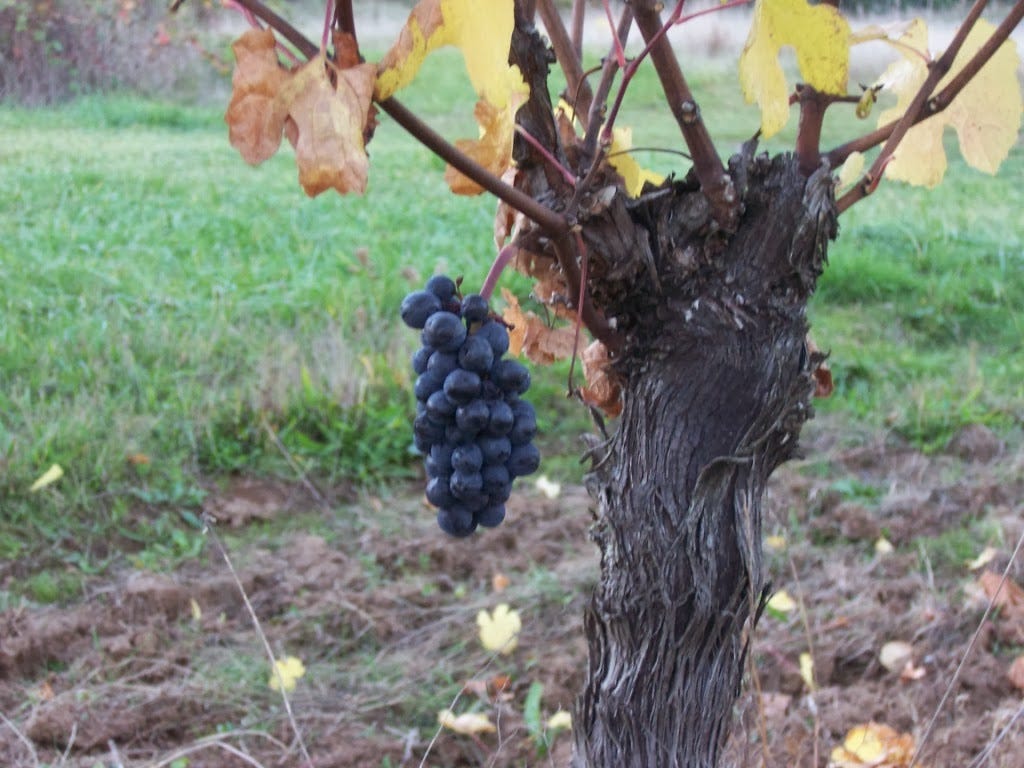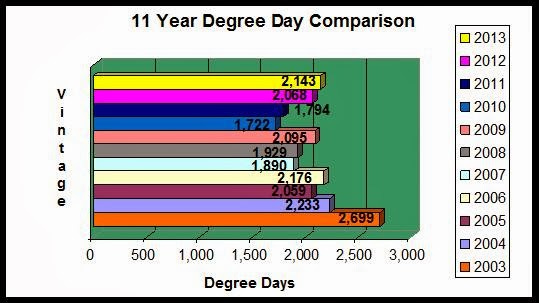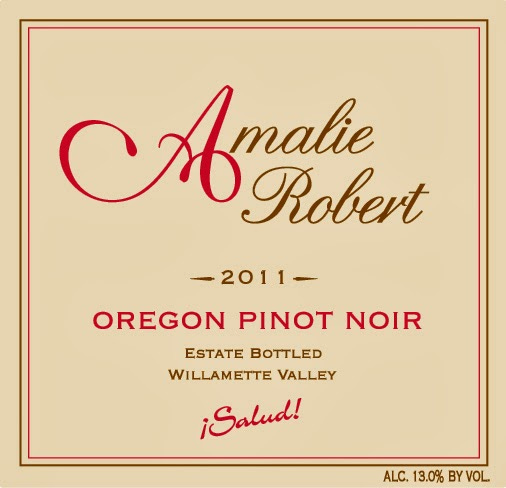Amalie Robert Estate Climate Update: 2013 October "Late Harvest"
Hello and Welcome,
This is the “Late Harvest” Climate Update for October 2013.
Well, Typhoon Pabuk came and went. That kinda put a damper on the harvest operations for most folks. Something about 9 inches of rain in a 4 day window reminds Ernie of what his father used to say about packing 10 pounds of grit in a 5 pound bag. We certainly were over received. Oddly, no one knew it was coming. And this was before the self inflicted government shutdown. At least OUR website was still up and running.
Once the ocean stopped falling out of the sky at a 45 degree down angle, it was cool and drizzly for a few days. The soil and permanent grassed rows did their work of soaking up the rains and recharging the dry soil profile. But they can only absorb so much so fast. The rest was run off. That is the sad truth about farming on hillsides and why Ernie is so keen to keep a rotational cover crop in the recycle rows. It takes a long time to build an inch of topsoil.
But, the cool weather during this time was quite helpful. As astute readers of this communication know, Botrytis is our nemesis as we cruise through the harvest window. Botrytis needs 2 things to take over your vineyard – warm temperatures and airborne moisture, also known as rain. The cool temperatures are what kept the fungus from taking us out. That and our elevated vineyard position allowed us to rise above all of the humidity that pooled at the lower elevations in our growing area. Success leaves clues.
Since we had a little time on our hands, we thought we would look a little more closely into this Noble Rot fungus. A more technical name is Botrytis Cinerea. But that is hard and somewhat awkward to work into a conversation around the end post, hence the shortening to just Botrytis. To be more accurate and specific we should be saying Botryotinia Fuckeliana*.
Botryotinia Fuckeliana is the causal (some may say casual) agent of gray mold disease, better known as Botrytis Cinerea. What this means is actually very simple. Botryotinia Fuckeliana is a fungus that reproduces sexually, while Botrytis Cinerea is a form of the fungus that reproduces asexually. Either way, once they get started watch out. It does not take long to turn ripe, healthy mature fruit into a mycological nightmare. Or does it?

A surprising thing happened on our way to Halloween this year, a very unique and unprecedented thing to be sure. Even more special than that 2007 vintage! It stopped raining, the sun reappeared, the breeze picked up and it remained mild during the day and cool at night. It was about the 5th of the month when we got this “go” sign directly from Ma herself to start harvest. And we did!

We also rely on the tried and true Walnut tree. Every year we sample the vineyard, check the sugars and acids and taste the fruit. We develop a detailed “Harvest Package” day by day to schedule the blocks we want to harvest and in what order. The birds certainly have some input into these harvest logistics. But all we really need to do is watch this majestic Walnut tree. Every year the fruit hangs until we see this magnificent torch appear.
We were picking Pinot Meunier and Pinot Noir just about as fast as the birds were. Bear in mind they are uniquely suited to this activity much more so than humans, opposable thumbs or not. Having experienced 2010, where about 300 cases of wine flew away, Ernie decided to get out the nets. Oddly enough, birds and fish share a common failing when it comes to understanding nets. Yeah, that slowed ‘em down and kept a little more fruit on the vine so that we could hang it to optimal ripening. Optimal, of course, is a relative term, but it is vintage specific.
About the 9th of October we decided we better have a look at the Chardonnay. Sure as grit, there was a fair farmin’ bit of Botryotinia Fuckeliana going down. Ernie likes to see a little bit of this activity before harvest, but this was something other. So we plucked the clusters we could, declared victory and got back to the Pinot Noir. By then Peaches had returned, with friends.
We had 4 very nice looking does join us one morning for harvest. The new deer fence is quite effective indeed, as they could not get out. From their point of view, why would they? There were several clones of Pinot Noir to choose from and even a few new shoot tips here and there. Life was good, good, good.
And not so good for the robin who was ensnared in one of the nets. Not his lucky day as he attracted the attention of Geoffrey Chambertin, our resident Redtail hawk. You win some, you lose some and some get Botryotinia Fuckeliana.

As we wrapped up the Pinot Noir cluster pluck, (which was just farmin’ great, mind you) we had Chardonnay on our minds. Ernie took a walk to revisit the carnage. Yeah, they were brown, and yeah, they were shriveling on the vine, but they were sweet and surprisingly, they did NOT taste like mold. Well now, what the Botryotinia Fuckeliana do we have here?
What we have here is Noble Rot, plain and simple. It is a very rare year in the Willamette Valleywhere the conditions turn from rainy to dry in the fall. In 2013, that was the exact weather pattern after we were inoculated by Typhoon Pabuk. What to do?
One of the most fundamental things in farming is to know what you can fix, what you need to replace and how to tell the difference. Ernie did not know how to deal with this noble gift, so he did what Ernie does. He called Dick Erath.
Dick made it down to the farm late in October. They took a tour of the Chardonnay and decided it was not such a sad little tree after all (sorry, wrong movie.) A quick snip with Dick’s knife and in no time they had plucked a few clusters. Back in the lab Ernie squeezed those little berries until they gave up their secrets. Here is what they said “37.4 Brix at 3.42 pH and our seeds are brown. That is all we know. Well, that and it is going to rain eventually.”
That was enough. Dick shared a late harvest wine he had made from another greatly misunderstood vintage – 1997. He said it was the kind of wine you could apply topically, and remove orally. That was a point not lost on Ernie as he had Botryotinia Fuckeliana on his mind. With Dick’s help, Ernie got to thinking about how to turn those grapes from block 24 into sweet nectar. We commenced our Late Harvest BFC run on October 28th. Stay tuned for scenes from our next episode.
Why yes, we make Rhône wines! The Viognier from 2013 is an aromatic wonderland of homemade peach jam, white apricots, cinnamon and tamarind. We may even bottle some if Ernie doesn’t sample it all first. Estimated production is 5.5 cases, down from the 16 cases produced and bottled from 2012. Maybe this sequester thing is getting a little out of hand.
The Syrah came rolling in on October 31st. We hang it until it looks like we are going into a severe rain pattern. It can use all the hang time it can get. The light fruit set also affected this variety with an estimated production of just 2 barrels, or about 50 cases. Yeah, that’s farmin’.
If you have not had a chance to experience harvest, please take a moment to watch harvest at Amalie Robert Estate. The video was filmed and produced by VineStories. After watching an Amalie Robert Estate wine grape harvest, you may also enjoy learning more about the Spaghetti Harvest with this video.
Back by popular demand, the numbers. After the emotionally cleansing rains of September, we had a pretty nice October. From a harvest operations point of view, it was nice and we liked it! From a fruit point of view, we saw our first blocks of Pinot Noir come in around 21.0 Brix and our last blocks, the really good stuff, was taken around the 15th at around 24.0 Brix. Clearly the vines knew when to stop taking up water and get on with ripening their seeds. Curious little plants indeed.

For the first 15 days of October, we accumulated 6.8 Degree Days, for a growing season to date total of 2,143.1 Degree Days. Our high temperature was 77.0 and our low temperature was 34.2 degrees Fahrenheit. That cool weather really saved our acids! We accumulated 1.13 inches of rainfall through October 15th. Rainfall since April 1stis 22.50 inches.
Here is how we looked at mid-October in 2012:
The first half of Octo-Vember gave us 144 Degree Days. Our high temperature was a blistering 92.5 degrees and our low temperature was just above the frost level at 37.60. Rainfall for this 15 day period was 2.13 inches. Total 2012 growing season Degree Days represent a perfect cool climate vintage at 2,068 and rainfall checks in at 11.09 inches.

¡Salud!“The Premier Oregon Pinot Noir Auction” is being held November 8thand 9th and we will be showcasing the outstanding 2012 vintage. It’s not too late to purchase tickets to attend the ¡Salud! Pinot Noir auction this year. Please follow this link to learn more: www.saludauction.org
If you can not attend, but would like to enter a sealed bid, there is still time. For more information, please follow this link for more information about placing a sealed bid: http://www.saludauction.org/auction/the-oregon-pinot-noir-auction/auction-items/.
You may also contact Lindsay Coon at ¡Salud! by phone at 503-681-1850 or by e-mail at lindsay.coon@tuality.org.
Kindest Regards,
Dena & Ernie
* Botryotinia fuckeliana was named by mycologist Heinrich Anton de Bary in honor of another mycologist, Karl Wilhelm Gottlieb Leopold Fuckel.



